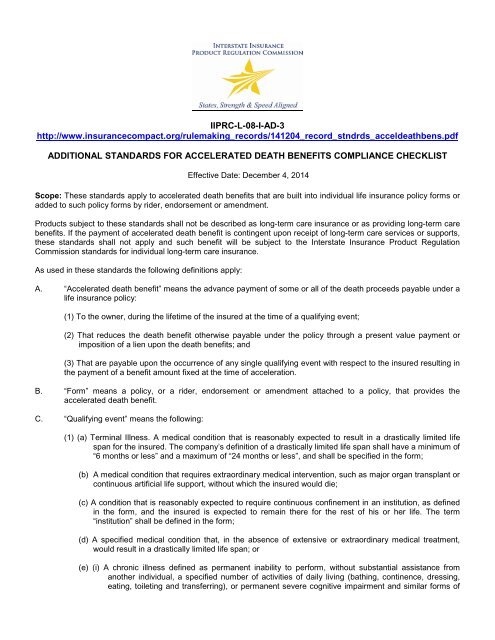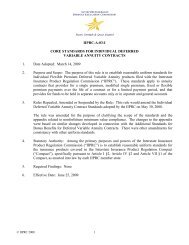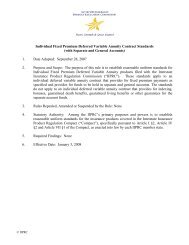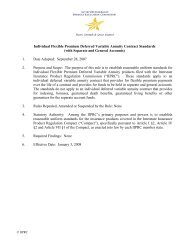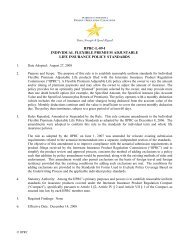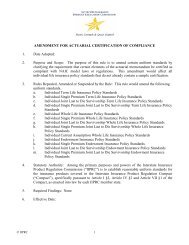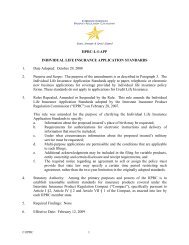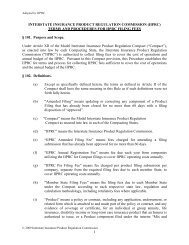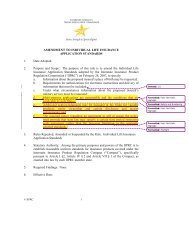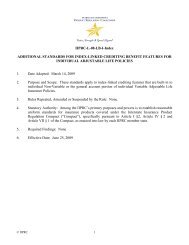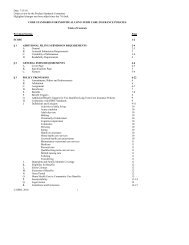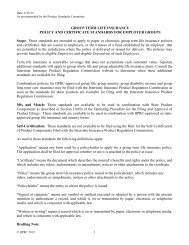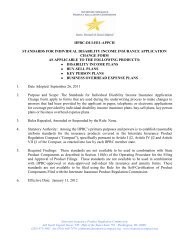These standards apply to accelerated death benefits that are built ...
These standards apply to accelerated death benefits that are built ...
These standards apply to accelerated death benefits that are built ...
Create successful ePaper yourself
Turn your PDF publications into a flip-book with our unique Google optimized e-Paper software.
IIPRC-L-08-I-AD-3http://www.insurancecompact.org/rulemaking_records/141204_record_stndrds_accel<strong>death</strong>bens.pdfADDITIONAL STANDARDS FOR ACCELERATED DEATH BENEFITS COMPLIANCE CHECKLISTEffective Date: December 4, 2014Scope: <strong>These</strong> <strong>standards</strong> <strong>apply</strong> <strong>to</strong> <strong>accelerated</strong> <strong>death</strong> <strong>benefits</strong> <strong>that</strong> <strong>are</strong> <strong>built</strong> in<strong>to</strong> individual life insurance policy forms oradded <strong>to</strong> such policy forms by rider, endorsement or amendment.Products subject <strong>to</strong> these <strong>standards</strong> shall not be described as long-term c<strong>are</strong> insurance or as providing long-term c<strong>are</strong><strong>benefits</strong>. If the payment of <strong>accelerated</strong> <strong>death</strong> benefit is contingent upon receipt of long-term c<strong>are</strong> services or supports,these <strong>standards</strong> shall not <strong>apply</strong> and such benefit will be subject <strong>to</strong> the Interstate Insurance Product RegulationCommission <strong>standards</strong> for individual long-term c<strong>are</strong> insurance.As used in these <strong>standards</strong> the following definitions <strong>apply</strong>:A. “Accelerated <strong>death</strong> benefit” means the advance payment of some or all of the <strong>death</strong> proceeds payable under alife insurance policy:(1) To the owner, during the lifetime of the insured at the time of a qualifying event;(2) That reduces the <strong>death</strong> benefit otherwise payable under the policy through a present value payment orimposition of a lien upon the <strong>death</strong> <strong>benefits</strong>; and(3) That <strong>are</strong> payable upon the occurrence of any single qualifying event with respect <strong>to</strong> the insured resulting inthe payment of a benefit amount fixed at the time of acceleration.B. “Form” means a policy, or a rider, endorsement or amendment attached <strong>to</strong> a policy, <strong>that</strong> provides the<strong>accelerated</strong> <strong>death</strong> benefit.C. “Qualifying event” means the following:(1) (a) Terminal Illness. A medical condition <strong>that</strong> is reasonably expected <strong>to</strong> result in a drastically limited lifespan for the insured. The company’s definition of a drastically limited life span shall have a minimum of“6 months or less” and a maximum of “24 months or less”, and shall be specified in the form;(b) A medical condition <strong>that</strong> requires extraordinary medical intervention, such as major organ transplant orcontinuous artificial life support, without which the insured would die;(c) A condition <strong>that</strong> is reasonably expected <strong>to</strong> require continuous confinement in an institution, as definedin the form, and the insured is expected <strong>to</strong> remain there for the rest of his or her life. The term“institution” shall be defined in the form;(d) A specified medical condition <strong>that</strong>, in the absence of extensive or extraordinary medical treatment,would result in a drastically limited life span; or(e) (i) A chronic illness defined as permanent inability <strong>to</strong> perform, without substantial assistance fromanother individual, a specified number of activities of daily living (bathing, continence, dressing,eating, <strong>to</strong>ileting and transferring), or permanent severe cognitive impairment and similar forms of
dementia. The company’s definition of chronic illness shall not require the inability <strong>to</strong> perform morethan two activities of daily living.(ii) For the purposes of complying with the requirements of IRC Section 7702B and IRC Section 101(g)(“federal requirements”), chronic illness may also be defined as prescribed in these federalrequirements, such as:(I) For activities of daily living, requiring the inability <strong>to</strong> perform such activities <strong>to</strong> be for a periodof at least 90 days;(II) For Periodic payments, requiring <strong>that</strong> within the preceding 12-month benefit period alicensed health c<strong>are</strong> practitioner has certified <strong>that</strong> the insured meets the requirements of IRCSection 7702B(c)(2)(A); and(III) For cognitive impairment, requiring substantial supervision.(2) A Terminal Illness qualifying event must always be included. The company may also provide <strong>accelerated</strong> <strong>benefits</strong>upon the occurrence of other qualifying events. If the <strong>accelerated</strong> <strong>death</strong> benefit provides multiple qualifying events, theinsured meeting the conditions of any one specified qualifying event shall be sufficient <strong>to</strong> entitle the owner <strong>to</strong>accelerate the <strong>death</strong> benefit.Mix and Match: <strong>These</strong> <strong>standards</strong> <strong>are</strong> available <strong>to</strong> be used in combination with State Product Components asdescribed in Section 111(b) of the Operating Procedure for the Filing and Approval of Product Filings(http://www.insurancecompact.org/rulemaking_records/081011_product_filing_app_A.pdf). Please note <strong>that</strong> thisapplies <strong>to</strong> the entire state or Compact approved forms and NOT <strong>to</strong> particular provisions contained within such forms.Submit the following:1. STATEMENT OF INTENT indicating the intent <strong>to</strong> use one or more State Product Components with a CommissionProduct Component. The Statement of Intent must identify the Compacting State(s) wherein the combined ProductComponents will be offered or sold, and sufficiently identify for each of such Compacting State(s) the StateComponent(s) <strong>that</strong> will be used with the Commission Component by listing the form numbers and Compacting Stateapproval dates; and2. CERTIFICATION stating <strong>that</strong> the combination of a Commission Component and a State Component does notcontain inconsistent, ambiguous, unfair, inequitable or misleading clauses, or exceptions or conditions <strong>that</strong>unreasonably affect the risk purported <strong>to</strong> be assumed. The Certification must be signed by a company officer. ThisCertification shall not give rise <strong>to</strong> any presumption <strong>that</strong> the combination of Product Components, in fact, meets thisstandard for purposes of any action by the Commissioner of a Compacting State <strong>to</strong> prohibit the combined use of aCommission Product Component with a State Product Component.http://www.insurancecompact.org/documents/industry_resources_soi_pt1.pdfSelf-Certification: <strong>These</strong> <strong>standards</strong> <strong>are</strong> not available <strong>to</strong> be filed using the Rule for the Self-Certification of ProductComponents Filed with the Interstate Insurance Product Regulation Commission. Any deviation from the <strong>standards</strong>prescribed shall require prior approval.The following Filing Information Notice (FIN) provides more guidance regarding the submission of filings using the “mixand match” process: http://www.insurancecompact.org/documents/fin_2009-4.pdf
§ 1 ADDITIONAL SUBMISSION REQUIREMENTSA. GENERALYES N/AThe following additional filing submission requirements shall <strong>apply</strong>:(1) Include a statement of the types of policy forms with which this benefit will be offered, anyunderwriting restrictions involving benefit amounts or age, and whether the benefit is intended foruse with new issues and/or in force business.(2) Include specimen issue of the statement required by item 1, as applicable, and Item 2 ofSection 3.C, and an explanation of how and when the statement will be provided.YESNAB. ACTUARIAL MEMORANDUM REQUIREMENTS(1) Include an actuarial memorandum prep<strong>are</strong>d, dated and signed by a member of the AmericanAcademy of Actuaries who provides the following information:(a) A description of the <strong>accelerated</strong> <strong>death</strong> benefit, including the effects of payment of the<strong>accelerated</strong> <strong>death</strong> benefit on all policy <strong>benefits</strong>, premium payments, cost of insurance rates, andvalues, including any outstanding loan, if applicable, for all types of forms with which the<strong>accelerated</strong> <strong>death</strong> benefit will be used;(b) A description of and justification for expense charges associated with the <strong>accelerated</strong> <strong>death</strong>benefit and the maximum expense charges. If such charges exceed $250, include a detailedexplanation;(c) A description of the interest rate or interest rate methodology used in any present valuecalculation or in accruing interest on the amount of the <strong>accelerated</strong> <strong>death</strong> benefit. The maximuminterest rate shall not exceed the greater of:(i) The current yield on 90-day treasury bills available on the date of application or <strong>accelerated</strong>payment; or(ii) The current maximum adjustable policy loan interest rate based on the Moody’s CorporateBond Yield Averages – Monthly Average Corporates published by Moody’s Inves<strong>to</strong>r Service,Inc., or successor there<strong>to</strong>, for the calendar month ending two months before the date ofapplication for an <strong>accelerated</strong> payment. The policy loan interest rate is <strong>that</strong> which is permittedunder the NAIC Model Policy Loan Interest Rate Bill (#590);(d) A description of the mortality basis and methodology, including the period of time applicable<strong>to</strong> any mortality discount, used in any present value calculation of the <strong>accelerated</strong> <strong>death</strong> benefit;(e) A description of the mortality and morbidity basis and methodology used in the determinationof any separate premium or costs of insurance (COI) for the <strong>accelerated</strong> <strong>death</strong> benefit;(f) The formula used <strong>to</strong> determine the <strong>accelerated</strong> <strong>death</strong> benefit, including any limitations on theamount of the benefit, and the formula used <strong>to</strong> determine the post-acceleration premium;(g) A sample calculation of the <strong>accelerated</strong> <strong>death</strong> benefit. If the policy contains a loan provision,the example shall assume <strong>that</strong> there is an outstanding loan at date of acceleration. All policy<strong>benefits</strong>, premium payments, COI charges and values, including the outstanding loan, ifapplicable, immediately before and immediately after acceleration must be shown in the example;(h) If an <strong>accelerated</strong> <strong>death</strong> benefit may be made in periodic payments, the basis used in thecalculation of the minimum periodic payment for the payment period and a sample calculation ofa minimum periodic payment. Identify the basis used and provide a sample calculation of thelump sum payable if the insured dies before all periodic payments for the payment period <strong>are</strong>made; and(i) For any <strong>accelerated</strong> <strong>death</strong> benefit of the type described in items 1(b), (c), (d), and (e) of the“Qualifying event” definition contained in this these <strong>standards</strong>, a certification <strong>that</strong> the value andpremium of the <strong>accelerated</strong> <strong>death</strong> benefit is incidental <strong>to</strong> the life coverage, as per the Incidental
Value and Premium/Cost of Insurance Rate Relationship Certification shown in Appendix A.§ 2 GENERAL FORM REQUIREMENTSYES N/AYES N/AA. COVER PAGE OR FIRST PAGE(1) The cover page of the policy if the benefit is <strong>built</strong> in<strong>to</strong> the policy, or the first page of the rider,endorsement, or amendment shall include the following in prominent print:(a) The term “<strong>accelerated</strong> <strong>death</strong> benefit” shall be included in the brief description or descriptive title ofthe form.(b) A clear statement <strong>that</strong> the <strong>death</strong> benefit and any accumulation values and cash values, and, ifapplicable, premium payments or COI charges, will be reduced if an <strong>accelerated</strong> <strong>death</strong> benefit is paid.(c) A clear statement <strong>that</strong> the owner should seek additional information from his personal tax advisorabout the tax status of the <strong>accelerated</strong> <strong>death</strong> benefit payment.“Prominent print” means, for example, all capital letters, contrasting color, underlined or otherwisedifferentiated from the other type on the form.B. FAIRNESS(1) The form shall not contain provisions <strong>that</strong> unfairly discriminate among insureds with differingqualifying events covered under the form, or among insureds with similar qualifying events coveredunder the form.§ 3 ACCELERATED DEATH BENEFIT PROVISIONSYES N/AYES N/AA. BENEFIT AMOUNT(1) The form may limit the percentage or dollar amount of the policy <strong>death</strong> benefit <strong>that</strong> may be<strong>accelerated</strong>. Any minimum or maximum limit shall be specified in the form.B. BENEFIT DESIGN OPTIONS(1) The form shall describe the <strong>accelerated</strong> <strong>death</strong> benefit option or options <strong>that</strong> <strong>are</strong> available <strong>to</strong> theowner, such as the payment of all of the <strong>death</strong> benefit of the policy, the payment of part of the <strong>death</strong>benefit of the policy, or a lien on the <strong>death</strong> benefit of the policy.(2) If the form allows for the present value calculation, the form shall:(a) Specify the amount of the <strong>death</strong> benefit of the policy <strong>that</strong> may be <strong>accelerated</strong> by the owner;(b) State <strong>that</strong> the company may <strong>apply</strong> a portion of the <strong>accelerated</strong> <strong>death</strong> benefit <strong>to</strong> repay an outstandingpolicy loan but only up <strong>to</strong> the amount of the outstanding policy loan multiplied by the percentage ofthe policy <strong>death</strong> benefit <strong>that</strong> has been <strong>accelerated</strong>;(c) State <strong>that</strong> the premium shall be reduced <strong>to</strong> the premium <strong>that</strong> would <strong>apply</strong> had the policy been issuedat the reduced amount, and may be further reduced according <strong>to</strong> some defined formula, such as prorata reduction, or become paid-up;(d) State <strong>that</strong> the company may pay the owner a present value of the policy <strong>death</strong> benefit <strong>that</strong> is being<strong>accelerated</strong>. The interest rate or interest rate methodology used in the calculation shall be disclosed
in the form; and(e) State <strong>that</strong> the policy cash value, if any, shall be reduced by the same percentage as the policy <strong>death</strong>benefit.(3) If the form allows the payment <strong>to</strong> the owner of the <strong>accelerated</strong> <strong>death</strong> benefit <strong>to</strong> be treated as a lien onthe <strong>death</strong> <strong>benefits</strong> of the policy, the form shall state <strong>that</strong>:(a) The lien may be applied only against the policy <strong>death</strong> benefit, not against any policy cash value;(b) Interest bearing liens <strong>are</strong> permitted. The interest rate accrued on the portion of the lien which is equal<strong>to</strong> the cash value of the policy at the time of acceleration shall be no more than the policy loaninterest rate stated in the policy. For the amount of the lien in excess of such cash value, the interestrate or interest rate methodology shall be disclosed in the form;(c) Expense charges may be added <strong>to</strong> the lien;(d) Due and unpaid premiums may be included in the lien after the au<strong>to</strong>matic premium loan, if available,is exercised; and(e) Access <strong>to</strong> the policy cash value may be restricted <strong>to</strong> the excess of the cash value over the sum of thelien and any other outstanding policy loans.(4) The form shall disclose any premium charge or cost of insurance charge for the <strong>accelerated</strong> <strong>death</strong>benefit. A premium charge or cost of insurance charge is prohibited for a qualifying event of the typedescribed in item 1(a) of the “qualifying event” definition contained in this these <strong>standards</strong>.(5) The form shall not require <strong>that</strong>, upon acceleration of part of the policy <strong>death</strong> benefit, the insuredforfeits the remainder of the policy <strong>death</strong> benefit.(6) The form shall not include an aggregate limit provision <strong>that</strong> caps the <strong>accelerated</strong> <strong>death</strong> <strong>benefits</strong>payable for all policies issued by the company and its subsidiaries and affiliates.(7) The form shall not require <strong>that</strong> the <strong>accelerated</strong> <strong>death</strong> benefit will be provided only if the policy wouldremain in force for a specific period of time following acceleration. However, the option may excludefrom acceleration any term insurance coverage scheduled <strong>to</strong> terminate prior <strong>to</strong> the end of the period used<strong>to</strong> define a qualifying event of the type described in item 1(a) of the “qualifying event” definitioncontained in these <strong>standards</strong>.(8) The form shall not contain any restrictions on the use of the <strong>accelerated</strong> <strong>death</strong> benefit proceeds.(9) The form may include an option at the time of acceleration <strong>to</strong> reduce the <strong>accelerated</strong> <strong>death</strong> benefitpayment by an amount actuarially determined <strong>to</strong> pay any remaining premiums.YES N/AC. EFFECT OF BENEFIT PAYMENT ON OTHER BENEFIT PROVISIONS(1) For forms delivered or issued for delivery in a state <strong>that</strong> may require pursuant <strong>to</strong> state law <strong>that</strong> astatement be provided <strong>to</strong> the applicant at the time of application for a form containing <strong>accelerated</strong> <strong>death</strong><strong>benefits</strong>, the content of such a written statement shall comply with these uniform <strong>standards</strong> for<strong>accelerated</strong> <strong>death</strong> <strong>benefits</strong> approved by the Interstate Insurance Product Regulation Commission. Thewritten statement shall include, but not necessarily be limited <strong>to</strong>, the following elements and shall beprovided <strong>to</strong> the applicant at the time of application for <strong>accelerated</strong> <strong>death</strong> <strong>benefits</strong>:(a) A brief description of the <strong>accelerated</strong> <strong>death</strong> benefit;(b) A description of all qualifying events <strong>that</strong> can trigger the payment of the <strong>accelerated</strong> <strong>death</strong> benefit;(c) A description of any premium cost of insurance charge for the <strong>accelerated</strong> benefit.(d) A description of the effect of payment of the <strong>accelerated</strong> <strong>benefits</strong> on the policy’s cash value,accumulation amount, <strong>death</strong> benefit, premium, policy loans and policy liens, as applicable;
(e) A statement <strong>that</strong> an administrative expense charge and an interest charge may <strong>apply</strong> at the time ofacceleration.(f) A statement whether the <strong>accelerated</strong> <strong>benefits</strong> <strong>are</strong> intended <strong>to</strong> qualify for favorable tax treatment;(g) A statement <strong>that</strong> there <strong>are</strong> circumstances when receipt of <strong>accelerated</strong> benefit payment may be taxableand assistance should be sought from a personal tax advisor.(h) A statement <strong>that</strong> receipt of <strong>accelerated</strong> <strong>benefits</strong> may adversely affect the recipient’s eligibility forMedicaid or other government <strong>benefits</strong> or entitlements; and(i) A statement <strong>that</strong> the <strong>accelerated</strong> <strong>benefits</strong> do not and <strong>are</strong> not intended <strong>to</strong> qualify as long-term c<strong>are</strong>insurance.Check which states require written statement <strong>to</strong> be provided <strong>to</strong> the applicant at the time of application fora form containing <strong>accelerated</strong> <strong>death</strong> <strong>benefits</strong>.(2) The form shall state <strong>that</strong> (a) upon a request <strong>to</strong> accelerate the policy <strong>death</strong> <strong>benefits</strong> and (b) upon thepayment of the <strong>accelerated</strong> <strong>death</strong> benefit, the owner and any irrevocable beneficiary shall be given astatement demonstrating the effect of the acceleration of the payment of <strong>death</strong> <strong>benefits</strong> on the cash value,<strong>death</strong> benefit, premium, COI charges, and policy loans (including policy liens) of the particular policyinvolved. The statement shall display any premium or COI charges necessary <strong>to</strong> continue any remainingcoverage following the acceleration, and shall disclose all expense and interest charges associated withaccelerating the <strong>death</strong> benefit. Statements for use with liens shall say <strong>that</strong> future due and unpaidpremiums or COI charges may be included in the lien if the provision so provides. The statement shallbe based only on guaranteed values. No projected or nonguaranteed values or <strong>benefits</strong> may be shown.The statement shall include a disclosure <strong>that</strong> receipt of an <strong>accelerated</strong> <strong>death</strong> benefit may affect eligibilityfor Medicaid or other government <strong>benefits</strong> or entitlements and may have income tax consequences.(3) The form shall describe the effect of acceleration on premiums, COI charges, cash values and loanvalues, as applicable.(4) The form shall describe the effect <strong>that</strong> acceleration will have on coverage on another insured underthe policy.(5) The form may state <strong>that</strong> the owner cannot be required <strong>to</strong> <strong>apply</strong> for the <strong>accelerated</strong> <strong>death</strong> benefitbefore qualifying for Medicaid, or be required by credi<strong>to</strong>rs <strong>to</strong> <strong>apply</strong> for the <strong>accelerated</strong> <strong>death</strong> benefit.(6) When a part of the <strong>death</strong> benefit remains after payment of the <strong>accelerated</strong> <strong>death</strong> benefit, the followingrequirements shall <strong>apply</strong>:(a) Where the <strong>accelerated</strong> <strong>death</strong> benefit is paid under a present value calculation, the policy shall bemodified by an endorsement, which includes a statement of cash values, policy loans, premiums, COIcharges, and <strong>death</strong> <strong>benefits</strong> following acceleration;(b) The dividends or non-guaranteed elements credited shall not discriminate between policies whose<strong>death</strong> <strong>benefits</strong> have been reduced through acceleration and policies originally issued in the amount of thereduced <strong>death</strong> <strong>benefits</strong>; and(c) The accidental <strong>death</strong> benefit provision, if any, in the policy shall not be affected by the payment ofthe <strong>accelerated</strong> <strong>death</strong> benefit.YES N/AYES N/AD. EXCLUSIONS/RESTRICTIONS(1) The form shall not contain exclusions or restrictions for an <strong>accelerated</strong> <strong>death</strong> benefit <strong>that</strong> <strong>are</strong> not alsoexclusions or restrictions in the policy.E. EXPENSE CHARGES(1) The company may deduct one expense charge for each acceleration of the <strong>death</strong> benefit, asapplicable, and if an expense charge will be deducted, the company shall state the maximum expensecharge in the form.
(2) The form shall provide <strong>that</strong> if any index used in determining interest or expense charges isdiscontinued, the company will use an appropriate substitute index subject <strong>to</strong> the approval of theInterstate Insurance Product Regulation Commission.YES N/AYES N/AF. INCONTESTABILITY(1) The form shall be incontestable on the same, or a more favorable basis, as the individual policy.G. PAYMENT OPTIONS(1) The form shall describe the payment options available <strong>to</strong> the owner. The description shall include theoption <strong>to</strong> receive the <strong>accelerated</strong> <strong>death</strong> benefit payment in a lump sum, and may include an option <strong>to</strong>receive the benefit in periodic payments for a period certain only.(a) The amount of the <strong>accelerated</strong> <strong>death</strong> benefit cannot be conditioned on the amount of time apolicyholder is expected <strong>to</strong> be confined in an institution or expected <strong>to</strong> survive.(b) An option <strong>to</strong> receive the benefit in periodic payments shall include a description of how suchperiodic payment will reduce the <strong>death</strong> benefit.(2) The form shall state <strong>that</strong> the amount payable as a lump sum shall be at least equal <strong>to</strong> the accelerationpercentage multiplied by the difference between the current policy cash value and any outstanding policyloans. The current policy cash value shall include any termination dividend payable on the surrender ofthe policy.(3) For purposes of complying with the requirements of IRC Section 7702B and IRC Section 101(g)(“federal requirements”),(a) Periodic payments may be subject <strong>to</strong> the per diem specifications of the federal requirements <strong>to</strong> avoidunfavorable tax consequences. If the application of the federal requirements results in a reduced<strong>accelerated</strong> benefit from <strong>that</strong> requested, the remaining <strong>death</strong> benefit <strong>that</strong> can be <strong>accelerated</strong> will beavailable for acceleration in future months.(b) Lump sum payments may be subject <strong>to</strong> the per diem specifications of the federal requirements <strong>to</strong>avoid unfavorable tax consequences, In this situation, the per diem payments <strong>are</strong> annualized <strong>to</strong>determine the maximum lump sum amount payable every 12 months. If the application of the federalrequirement results in a reduced <strong>accelerated</strong> benefit from <strong>that</strong> requested, the remaining <strong>death</strong> benefit <strong>that</strong>can be <strong>accelerated</strong> shall be available for acceleration in future months.(c) If, before the payment of the full acceleration benefit, whether periodic or lump sum, the insureddies, the payments shall cease and the remaining <strong>accelerated</strong> benefit shall be paid as a <strong>death</strong> benefitpursuant <strong>to</strong> the policy.(d) If, before the payment of the full acceleration benefit, the insured is not re-certified as having met thefederal requirements for chronic illness, the remaining <strong>accelerated</strong> benefit will be returned <strong>to</strong> the policy<strong>death</strong> benefit.(4) After an <strong>accelerated</strong> <strong>death</strong> benefit is paid, the premium may either be reduced <strong>to</strong> the premium <strong>that</strong>would <strong>apply</strong> for the remaining <strong>death</strong> benefit under the policy or the premium may remain the same,depending on how the <strong>accelerated</strong> <strong>death</strong> benefit amount is calculated. The form shall state howpremiums will be affected.(5) The company may include a waiver of premium benefit for the <strong>accelerated</strong> <strong>death</strong> benefit. The formshall explain any continuing premium requirements <strong>to</strong> keep the policy in force.YES N/AH. PAYMENT PROCEDURES(1) The form shall specify the procedures required <strong>to</strong> accelerate the <strong>death</strong> benefit of the policy. Theprocedures shall be at least as favorable as the following:(a) If the form states <strong>that</strong> the company requires the filing of a proof of eligibility claim form, the
company shall provide the claim form within 15 days of the acceleration request. If the claim formis not furnished within 15 days, it is considered <strong>that</strong> the claimant complied with the claimrequirements if the claimant submits written proof covering the occurrence, the character and theextent of the occurrence for which claim is made;(b) The form shall not provide for a time frame within which proof of eligibility must be provided;(c) The form may state <strong>that</strong> the company has the right <strong>to</strong> require a second or third medical opinion <strong>to</strong>confirm benefit eligibility. The form shall state <strong>that</strong> the second or third medical opinions <strong>are</strong> at thecompany’s expense. The second medical opinion may include a physical examination by aphysician designated by the company. In the case of conflicting opinions, eligibility for the<strong>accelerated</strong> <strong>death</strong> benefit shall be determined by a third medical opinion <strong>that</strong> is provided by aphysician <strong>that</strong> is mutually acceptable <strong>to</strong> the insured and the company;(d) The form shall state <strong>that</strong> the <strong>accelerated</strong> <strong>death</strong> benefit is paid <strong>to</strong> the owner or owner’s estate while theinsured is living, unless the benefit has been otherwise assigned or designated by the owner;(e) The form shall state <strong>that</strong> prior <strong>to</strong> the payment of the <strong>accelerated</strong> <strong>death</strong> benefit, the company shallobtain from any assignee or irrevocable beneficiary a signed acknowledgement of concurrence forpayout. If the company paying the <strong>accelerated</strong> <strong>death</strong> benefit is itself the assignee under the policy,no acknowledgement is required; and(f) The form shall state <strong>that</strong> payment of the <strong>accelerated</strong> <strong>death</strong> benefit is due immediately upon receipt ofthe due written proof of eligibility. Companies <strong>are</strong> subject <strong>to</strong> the requirements of the Death BenefitProceeds <strong>standards</strong> with respect <strong>to</strong> any delay in processing requests <strong>to</strong> accelerate the payment of<strong>death</strong> <strong>benefits</strong>.(2) The form shall specify what occurs if the insured dies before all payments of the <strong>accelerated</strong> <strong>death</strong>benefit <strong>are</strong> made. If the present value of remaining payments is paid, the interest rate used <strong>to</strong>calculate any present value of the settlement option shall be <strong>that</strong> assumed in calculating the originalpayments.(3) The form shall state <strong>that</strong> if the insured dies after the owner elects <strong>to</strong> receive <strong>accelerated</strong> <strong>death</strong> <strong>benefits</strong>but before any such <strong>benefits</strong> <strong>are</strong> received, the election shall be cancelled and the <strong>death</strong> benefit paidpursuant <strong>to</strong> the policy.YES N/AI. QUALIFYING EVENTS(1) The form shall specify the terms and conditions applicable <strong>to</strong> each qualifying event.(2) The form shall not require <strong>that</strong> the cause of a qualifying event first manifest itself or be diagnosedafter issuance of the individual policy or form.(3) The form shall not include a waiting period requirement. “Waiting period” means a period of timefollowing the date of issue of the <strong>accelerated</strong> <strong>death</strong> benefit during which the benefit is not in effect. Arequirement <strong>that</strong> the individual policy or form be in force past the incontestable period is prohibited.(4) The form may include an elimination period for the qualifying events described in items (c) and (e)of the qualifying event definition in these <strong>standards</strong>, other than chronic illness as defined for purposes ofcomplying with the requirements of Internal Revenue Code sections 7702B and 101g. The term“elimination period” means a specified period of time not <strong>to</strong> exceed 90 days during which the insuredmeets the terms of the qualifying event. The elimination period begins on the first day <strong>that</strong> the insuredmeets the terms of the qualifying event and ends at the end of the specified period. If the insured meetsthe terms of multiple qualifying events <strong>that</strong> <strong>are</strong> subject <strong>to</strong> elimination periods on the same day, theelimination periods for each applicable qualifying event shall run concurrently. During the eliminationperiod, the insured is required <strong>to</strong> continuously meet the terms of the qualifying event without
interruption. If at the end of the elimination period the insured continues <strong>to</strong> meet the terms of thequalifying event, the owner may <strong>apply</strong> for the <strong>accelerated</strong> <strong>death</strong> benefit.YES N/AYES N/AJ. REINSTATEMENT(1) The form shall include a reinstatement provision on the same, or more favorable, terms as containedin the policy.K. TERMINATION(1) The form shall state <strong>that</strong> the <strong>accelerated</strong> <strong>death</strong> benefit shall end at the earliest of:(a) Upon written request from the owner;(b) Upon termination of the policy; or(c) Upon nonpayment of any separate premium or COI charge for the <strong>accelerated</strong> <strong>death</strong> benefit, inaccordance with the provisions of the form or the policy.(2) The form may state <strong>that</strong> the <strong>accelerated</strong> <strong>death</strong> benefit may terminate when a nonforfeiture benefitbecomes effective under the policy.(3) The form shall state <strong>that</strong> if the <strong>accelerated</strong> <strong>death</strong> benefit ends, this shall not prejudice the payment of<strong>benefits</strong> for any qualifying event <strong>that</strong> occurred while the form was in force.The Reviewer Checklist is intended for the sole purpose of assisting a company product filer ("User") in understanding therequirements of the applicable Uniform Standard(s) for IIPRC product filings. Users <strong>are</strong> hereby notified not <strong>to</strong> rely solely upon theReviewer Checklist in preparing a product filing or in complying with the IIPRC Uniform Standards, Rules and OperatingProcedures. The User also acknowledges there is a possibility of human, mechanical or technical error in the development,presentation or use of the Reviewer Checklist. The Interstate Insurance Product Regulation Commission (Commission) accepts noliability for any loss, cost or damage caused by use of this <strong>to</strong>ol, including without limitation, direct or indirect, incidental, special,consequential or exemplary or punitive damages arising out of the use or inability <strong>to</strong> use the Reviewer Checklist. There <strong>are</strong> nowarranties either express or implied and User specifically acknowledges the Commission does not warrant the truth, accuracy orcompleteness of the Reviewer Checklist.


